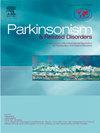震颤的临床神经生理学:临床实践中的常见问题。
IF 3.1
3区 医学
Q2 CLINICAL NEUROLOGY
引用次数: 0
摘要
背景:完整的病史和体格检查可能不足以全面研究震颤患者。在这种情况下,神经生理学可以作为身体检查的辅助手段。目的:我们的目的是提供令人信服的证据,支持神经生理学研究在各种震颤条件下的应用。方法:由运动障碍临床神经生理学研究小组召集的全球专家小组,研究了神经生理学在各种运动障碍中的应用和效用。结果:本文为震颤的电生理研究提供了详细的方法,有助于区分震颤与肌阵挛,比较帕金森与非典型帕金森震颤,描述肌张力障碍震颤,描述帕金森与原发性震颤的差异以及功能性震颤的特征。结论:神经生理学研究在鉴别震颤综合征和鉴别其他多动运动障碍方面起着至关重要的作用。本文章由计算机程序翻译,如有差异,请以英文原文为准。
Clinical neurophysiology for tremor: Common questions in clinical practice
Background
A thorough history and physical examination may be insufficient for comprehensively studying patients with tremor. In such instances, neurophysiology serves as an adjunct to the physical examination.
Objectives
Our aim is to present compelling evidence supporting the utilization of neurophysiological studies in various tremor conditions.
Methods
A panel of global experts, convened by the Study Group on Clinical Neurophysiology for Movement Disorders, examined the application and utility of neurophysiology across diverse movement disorders.
Results
This manuscript provides a detailed methodology for electrophysiological studies in tremors helping to differentiate them from myoclonus, comparing tremor in parkinson vs atypical parkinsonisms, describing dystonic tremor, describing the differences between Parkinson and essential tremor and the characteristics of functional tremor.
Conclusions
Neurophysiological studies play a crucial role in characterizing tremor syndromes and aiding in their differentiation from other hyperkinetic movement disorders.
求助全文
通过发布文献求助,成功后即可免费获取论文全文。
去求助
来源期刊

Parkinsonism & related disorders
医学-临床神经学
CiteScore
6.20
自引率
4.90%
发文量
292
审稿时长
39 days
期刊介绍:
Parkinsonism & Related Disorders publishes the results of basic and clinical research contributing to the understanding, diagnosis and treatment of all neurodegenerative syndromes in which Parkinsonism, Essential Tremor or related movement disorders may be a feature. Regular features will include: Review Articles, Point of View articles, Full-length Articles, Short Communications, Case Reports and Letter to the Editor.
 求助内容:
求助内容: 应助结果提醒方式:
应助结果提醒方式:


